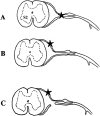Staggered rhizotomy of anterior and posterior sacral roots for bladder reservoir function in spinal cord injury: a canine experimental study and preliminary clinical report
- PMID: 22009834
- PMCID: PMC6583481
- DOI: 10.1111/j.1757-7861.2009.00025.x
Staggered rhizotomy of anterior and posterior sacral roots for bladder reservoir function in spinal cord injury: a canine experimental study and preliminary clinical report
Abstract
Objective: To report an experimental study and preliminary clinical results of staggered anterior and posterior sacral rhizotomy for restoring function of the bladder and preventing reflex incontinence in supra-conal spinal cord injury (SCI).
Methods: Ten T10 spinal cord transected mongrel dogs were divided into three groups. In group 1 (n= 2), laminectomy only was performed (control). In group 2 (n= 4), all L7-S3 posterior roots were microsurgically cut (complete deafferentation). And in group 3 (n= 4), the L7, S1, S3 posterior roots and S2 anterior root were cut (staggered deafferentation and deefferentation). Intraoperative electrical stimulation and postoperative cystometrography (CMG) were carried out. In the clinic, three patients with spastic bladder caused by a supra conal complete SCI underwent staggered rhizotomy and were followed up for 6 years.
Results: In the canine experimental study, resection of the S2 anterior root combined with L7, S1 and S3 posterior rhizotomy, stimulating the S2 posterior root (four dogs) resulted in a minimal rise in pressure in the bladder and urethra, which was only about 10% of that obtained by stimulating the S2 proximal posterior root while its anterior counterpart was intact (eight dogs, Student's t-test, P < 0.01). The CMG study showed that groups 2 and 3 had similar volume/pressure curves; in both groups the tendency was to develop flaccid bladders. In the clinic, three cases underwent staggered rhizotomy of the anterior and posterior roots in S3 and S4. Good bladder reservoir and compliance was achieved over six years of follow-up.
Conclusion: Staggered rhizotomy of the anterior and posterior sacral roots at different spinal cord levels has the same denervation effect as a complete posterior rhizotomy, and good bladder reservoir function can be achieved by this procedure.
© 2009 Tianjin Hospital and Blackwell Publishing Asia Pty Ltd.
Figures




Similar articles
-
[Experimental study on combining selective rhizotomy of different anterior and posterior sacral roots for restoration of bladder function after spinal cord injury].Zhongguo Xiu Fu Chong Jian Wai Ke Za Zhi. 2001 Mar;15(2):69-73. Zhongguo Xiu Fu Chong Jian Wai Ke Za Zhi. 2001. PMID: 11286164 Chinese.
-
[Experimental and clinical studies on selective sacral rhizotomy in treatment of spastic bladder after spinal cord injury].Zhongguo Xiu Fu Chong Jian Wai Ke Za Zhi. 2004 Sep;18(5):402-5. Zhongguo Xiu Fu Chong Jian Wai Ke Za Zhi. 2004. PMID: 15460055 Chinese.
-
Posterior sacral rhizotomy and intradural anterior sacral root stimulation for treatment of the spastic bladder in spinal cord injured patients.J Urol. 1997 Feb;157(2):610-4. J Urol. 1997. PMID: 8996369 Clinical Trial.
-
Restoration of bladder function in spastic neuropathic bladder using sacral deafferentation and different techniques of neurostimulation.Adv Exp Med Biol. 1999;462:303-9. doi: 10.1007/978-1-4615-4737-2_24. Adv Exp Med Biol. 1999. PMID: 10599434 Review.
-
Dorsal rhizotomy combined with anterior sacral root stimulation for neurogenic bladder.Acta Neurochir Suppl. 2007;97(Pt 1):323-31. doi: 10.1007/978-3-211-33079-1_43. Acta Neurochir Suppl. 2007. PMID: 17691393 Review.
Cited by
-
Bladder and Bowel Management in Dogs With Spinal Cord Injury.Front Vet Sci. 2020 Nov 11;7:583342. doi: 10.3389/fvets.2020.583342. eCollection 2020. Front Vet Sci. 2020. PMID: 33263015 Free PMC article. Review.
References
-
- Wyndaele JJ, Madersbacher H, Kovindha A. Conservative treatment of the neuropathic bladder in spinal cord injured patients. Spinal Cord, 2001, 39: 294–300. - PubMed
-
- Jamil F. Towards a catheter free status in neurogenic bladder dysfunction: a review of bladder management options in spinal cord injury. Spinal Cord, 2001, 39: 355–361. - PubMed
-
- Meirowsky AM, Scheibert CD, Hinchey TR. Studies on the sacral reflex arc in paraplegia; differential sacral neurotomy; an operative method. J Neurosurg, 1950, 7: 39–43. - PubMed
-
- Patton JF, Schwartz HG. Sacral neurotomy for the spastic neurogenic bladder. J Urol, 1953, 70: 230–233. - PubMed
-
- Misak SJ, Bunts RC, Ulmer JL, et al. Nerve interruption procedures in the urologic management of paraplegic patients. J Urol, 1962, 88: 392–401. - PubMed
Publication types
MeSH terms
LinkOut - more resources
Full Text Sources
Medical
Research Materials

